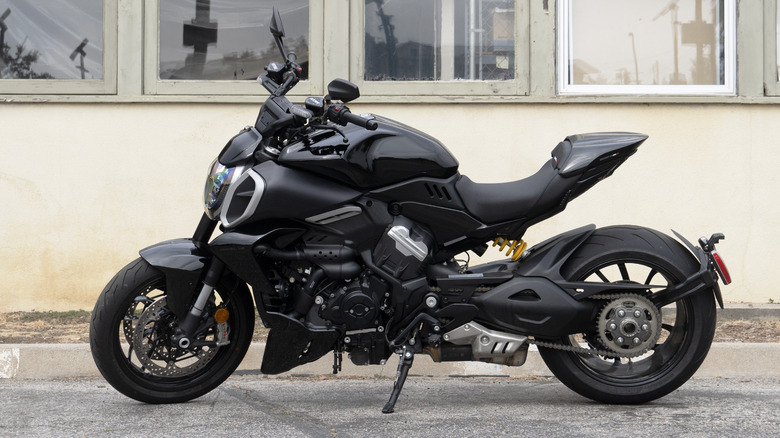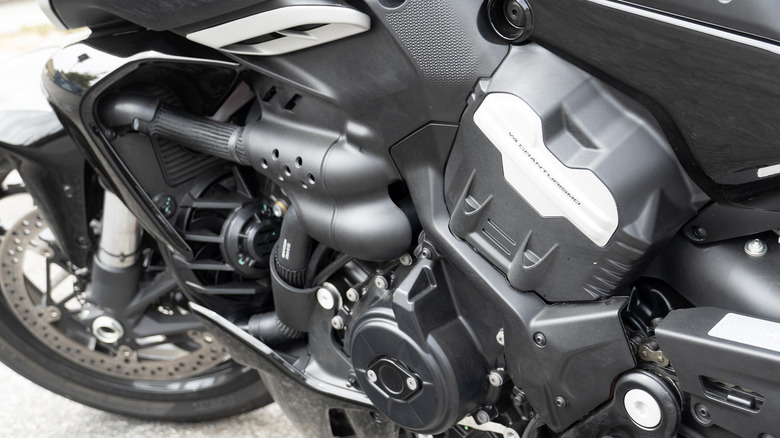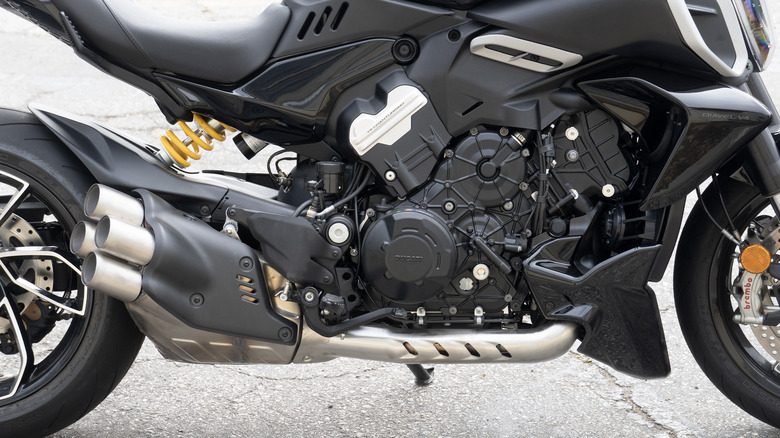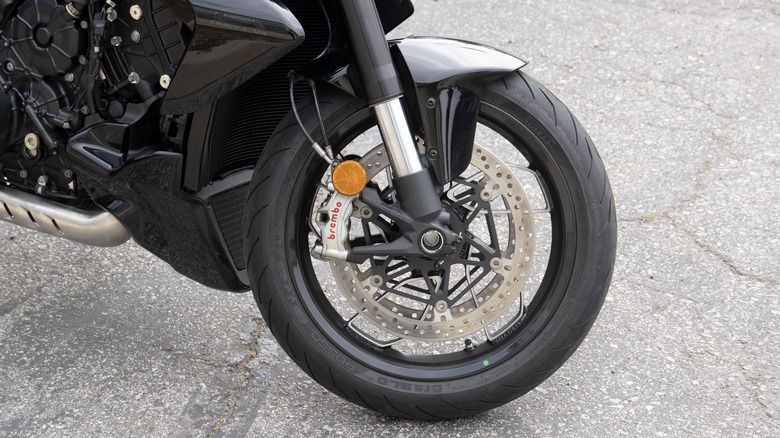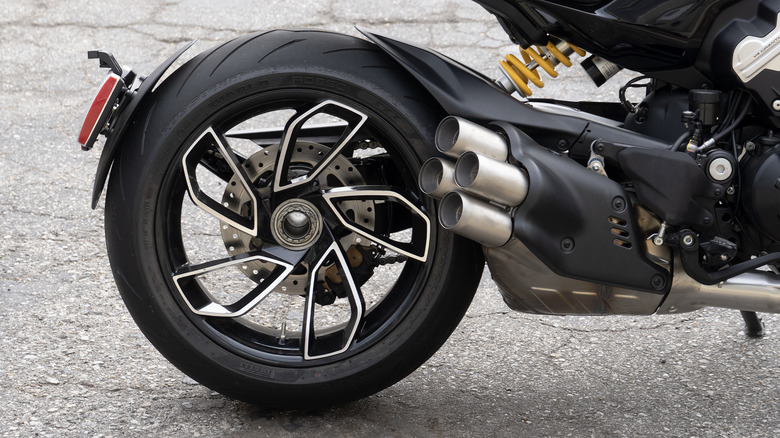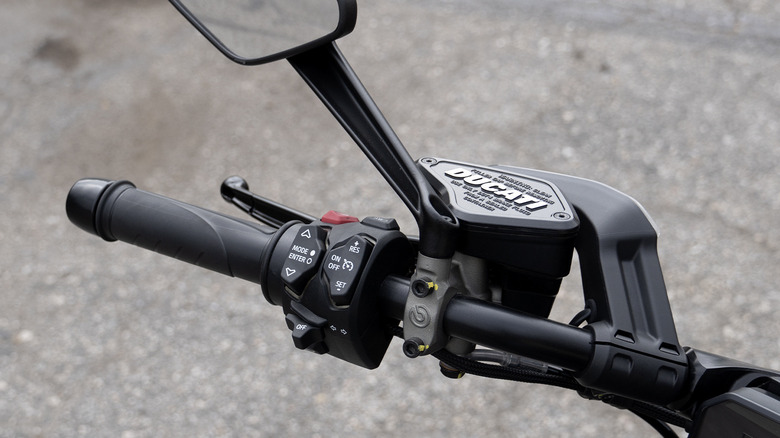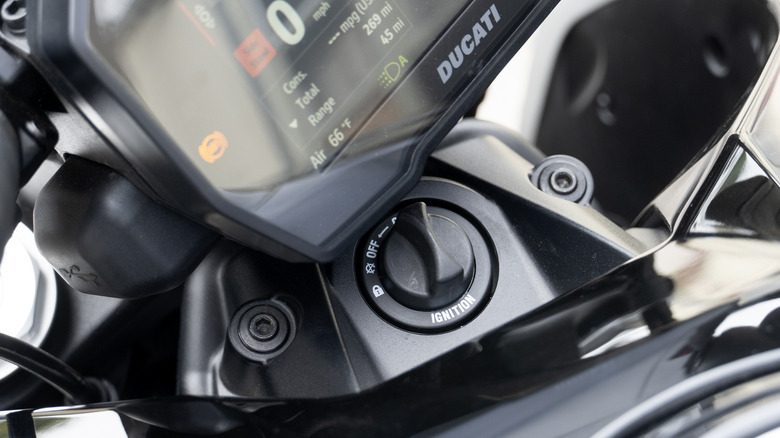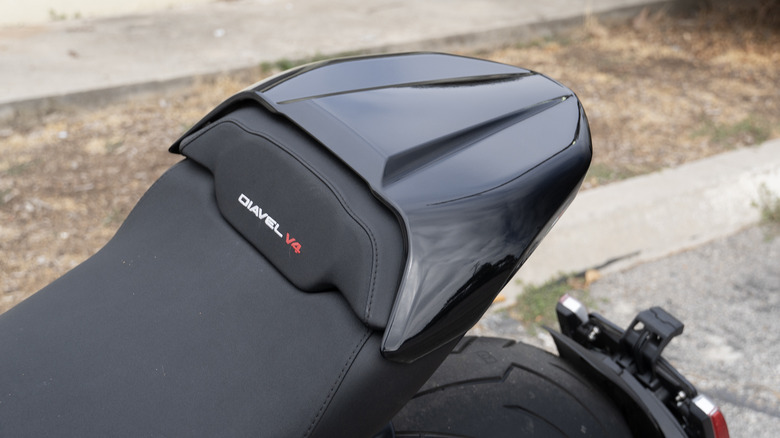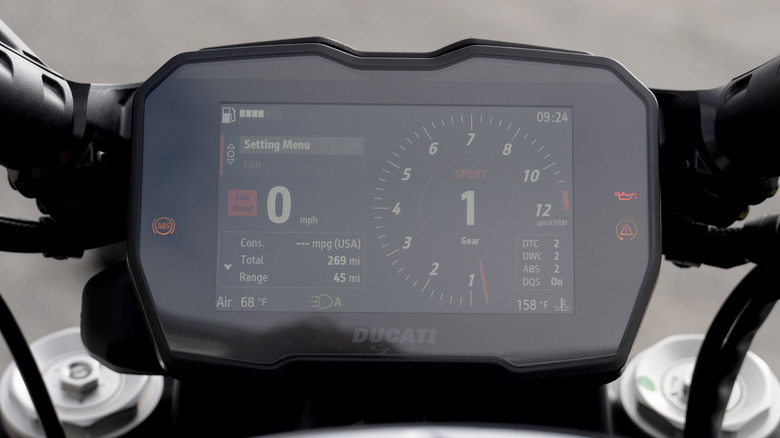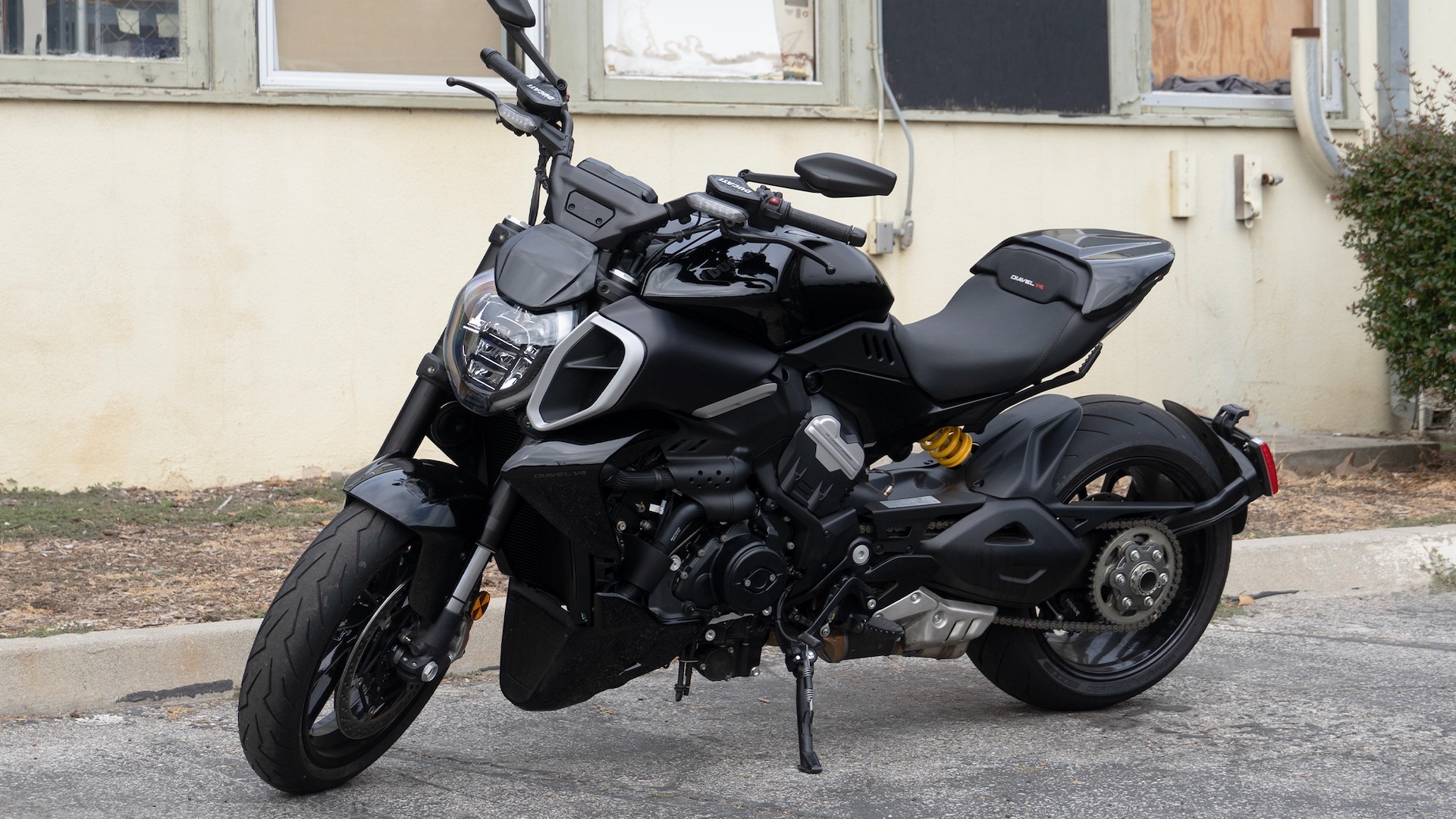2023 Ducati Diavel V4 Review: Dragging Toes On Ducati's Most Surprising Bike
- Powerful V4 engine
- Revised rider geometry
- Surprisingly sporty for a comfortable cruiser
- Styling is certainly subjective
- Weight savings were not a priority
- One of the most expensive Ducatis
Four turns up Latigo Canyon in Malibu, I drag the metal-reinforced right toe of my Daienese riding boots for the first time ever. Adjusting the ball of my foot higher up on the peg helps a little, but that nonetheless ends up being the first of many times throughout a day of hard-charging through the hills on Ducati's all-new Diavel V4.
Dragging toes on each side in a low lean makes a double-edged statement about the Diavel's cruiser-inspired footpeg position, but also the impressive level of sporty dynamics that this big bike delivers while riding as aggressively as possible (for me, at least). Back in town, meanwhile, the Diavel's revised geometry rides about as comfortably as anything on the market.
At first glance, the 2023 Diavel looks fairly similar to the outgoing model year: a fat rear tire, the low-slung profile, those massive air intakes, and high handlebars. But Ducati updated just about everything for this second generation, only enhancing the unique set of characteristics that the formerly unexpected Diavel delivers in spades.
Surprising stats for the new Diavel
Sometimes the world still surprises me. First of all, the Diavel debuted originally over a decade ago, with over 45,000 units sold since then. Who woulda thunk! At least, when this beefy cruiser from the iconic Italian sport bike manufacturer first arrived from way far out in left field, who could possibly have predicted the long production period and popularity?
Then I looked up the new bike's curb weight after that first ride up Latigo. Ducati claims 491 pounds without fuel or 520 pounds ready to ride. I never would have guessed those figures, either while shuffling the Diavel around my garage or hustling up the canyons at top speed. That's actually down a total of 28.6 pounds from the first generation, because the revamp for 2023 introduces a new engine cradled in a new monocoque frame.
The revisions also provide a new riding geometry with bars closer to a longer seat, as well as updated tech for the modern era. The styling of a semi-naked, new quad-tipped exhaust, a single-sided swingarm, and exposed hoses and mechanicals combine in a nightmarish menagerie—hence the Diavel name. And yet, ever since the first Diavels rolled out in 2011, Ducati somehow managed to marry those dual personalities in surprising fashion.
A second generation for Ducati's unexpected cruiser
The model-year updates only enhance everything that made the Diavel so unique from the get-go. First of all, the name alone switches from Diavel 1260 S to Diavel V4 in reference to the new 1154cc "Granturismo" engine borrowed from the Multistrada. Overall displacement for four cylinders actually drops from the previous 1262cc V-twin and Ducati tuned the mill in this case for more torque throughout the rev range, resulting in peak output of 168 horsepower and 93 lb-ft (up from 159 horsepower and down from 95 lb-ft for the 1260).
The new frame loses a few glimpses of the classic trellis-style lattice beneath the purposefully malevolent body panels, but allows the drivetrain to take over the grotesque styling's main responsibilities below a somewhat familiar fuel tank and those snorting air intakes. But minor differences to the bike's geometry create a different rider position, with a 10mm higher seat and the handlebars moved 20mm back towards the tail.
A closer look at the two bikes quickly reveals how much lower the engine and transmission sit, for a lower and sportier center of gravity that allows for easier transitions from side to side. Ducati also increased the single-sided swingarm's suspension travel by a substantial 15mm to smooth out jolts and jounces from the 240/45 rear tire.
The results of a monstrous makeover
As much as the fat rear tire and long, low forks suggest cruiser style, the overall profile hews closely to the modern naked bike phenomenon. And in a way, the new Diavel strongly resembles the new Monster introduced last year, which also lost the trellis frame while scooting the handlebars and seat closer together with a more humpbacked fuel tank in between. A smattering of 112 mean LEDs for taillights continues the theme. And perhaps we now know why no four-cylinder Monster has hit the lineup quite yet...
Much like the slightly more upright Monster, though, the Diavel's geometry toes the line between aggressively raked and upright comfortable characters. Sit up and lean back in town or hunch forward and lean out in the canyons: the Diavel now tempts me equally towards both riding styles. And the engine lives up to the dual challenges, too, with Ducati's first road-going application of cylinder deactivation that keeps only two cylinders firing below 4,000 rpm in every gear other than first.
Pulling hard away from a stoplight will keep all four chambers activated, but otherwise the transition from two to four combustions per rev only shows up with a slight bark of the quad-tipped exhaust. Even smoother than the Multistrada V4 Pikes Peak I rode, which often shifted from two to four and then back again just idling at stoplights or with the slightest pull of the clutch lever.
A new roar
Higher up in the power band, with the 1,154cc four-banger fully unleashed nearer to the 11,200-rpm redline, the quad exhaust wakes up to a full roar. But of every Ducati I've ridden so far, the Diavel sounds the best just tooling around town—probably thanks to the many tips of that exhaust. Stepping up to four cylinders from two seems to cause a bit more lurching from the Ducati Quickshifter, but otherwise the transmission lives up to expectations with a predictable slip point in the lever travel and positive engagement moving the left foot either up or down.
Shifting into neutral and then hauling down on both front and rear brakes will send the whole bike nose-diving onto the front wheel, though. That's thanks to a combination of that 520-pound wet weight and the immense stopping power of Brembo Stylema system, with four-piston fronts clamping on dual 330mm discs, plus a two-piston rear caliper on the single 265mm rotor. Ducati also brags about a radially mounted master cylinder, which I needed to look up, but simply means the master cylinder sits perpendicular to the motion of brake lever travel. The end result just feels substantial when braking in gear or coming into a curve while downshifting (playing with the enjoyable clutch or Quickshifter).
Pushing the Granturismo engine hard
Then a solid twist of throttle sets the Granturismo four-banger loose—really, at just about any RPM, no constant focus on perfectly nailed rev-matching or staying high up in the power band required. Triple-digit speeds approach almost immediately, as the lowslung geometry simple devours distances at previously unthinkable pace for such a behemoth of a bike.
Four ride modes help to tailor that power delivery to the scenario, selectable via familiar Ducati switchgear on the left grip and the 5-inch gauge display. Sport, Touring, Urban, and (new for this year) Wet adjust the levels at which traction control, ABS, and wheelie control intercede to prevent potential nastiness. But three power modes also adjust response noticeably, too.
For the most part, I fiddled around between Touring and Sport, ending up typically staying in Sport as my preferred selection for easiest and most confident throttle blips and acceleration, rather than also adjusting the power delivery to hone in on an absolutely perfect setting. But I only rode the bike a few times over the course of 10 days, and like more sensitive owners, might well have dialed in my perfect mode fiddling around with the electronic settings more if I kept the Diavel longer.
Adjusting to a new riding position
The somewhat incomparable design and purpose of the Diavel requires a bit of an adjustment period, without a doubt. That toe-dragging ride up Latigo took place probably about an hour into my first time out, as I grew accustomed to leaning out with my knees and feet far more forward than any other bike I've ever ridden. The geometry requires less thigh tuck up against the tank from the outside or the knee bent outward on the lower side, but rather I found that using more torso positioning and almost fully extending my outer elbow to countersteer seemed to produce the most confident position.
After a few hours of riding hard, when my knees and triceps might start to burn a bit on more dedicated sport bikes, the Diavel left me relatively unfazed. The upright posture and hip-to-leg angle all contribute to comfort throughout long days in the saddle, or while commuting back into town. The somewhat high seat—for a cruiser, at least—also produces excellent visibility in traffic (and the quad exhaust may or may not attract more attention, wanted or unwanted depending on the scenario). Despite the overall weight, the Diavel still seems nimble enough to lane-split, too, and pulling away from even freeway traffic never overwhelms the Granturismo powerplant.
A few disappointing aspects cropped up during the course of my time with the Diavel, the most annoying of which involves the new keyless start knob tucked deep underneath the gauge screen. Because of the cramped quarters, turning the little knob to the left to start up the bike requires taking off gloves—and still a bit of contortionism (I can palm a basketball, but my hands are not crazy huge). Plus, filling up the 5.2-gallong gas tank then requires pulling the key out of leathers or thick gear to unlock the fuel filler cap.
Customization options for Diavel customers
Ducati, of course, knows that the specific subset of customers who see the Diavel and think both the original and new designs nailed perfection in every way will still likely want to customize their bikes to stand out more, just in case they ever see another Diavel out on a ride. Saddlebags might further enhance the cruiser aesthetic, no additional frames or rails required. Pull off the plastic rear pillion cover and fold down the rear pegs, then install an optional passenger backrest or touring windscreen for the full passenger experience.
Or, go sportier with an optional dry clutch (Ducati advises for race use only, but we all know what that means) or an Akrapovic titanium race exhaust (same). Personally, if this Diavel V4 were mine, I might soften up the manually adjustable forks to help handle the heft on speed bumps or wavier roads.
But from the weight to the style to the entire ethos, I could have told you from the beginning that the Diavel isn't for me—even if it weighs less than before, rides better than before, or stunned me by how fast I managed to rip around Malibu.
A Diavel S might only add more sticker shock
We don't yet know whether Ducati will add a four-cylinder engine to the Monster lineup, given that the current differences between the base, Plus, and SP focus more on suspension, brakes, tires, and the hilariously optional combination of a windscreen plus pillion pad. A V4S variant of the Diavel almost seems more likely, with electronically adjustable Öhlins dampers taken from the Multistrada V4 Pikes Peak, and perhaps slightly raised foot pegs to prevent that toe dragging at the sharpest lean angles.
But those enhancements to the sporty side of the equation would also add to the Diavel's already steep sticker of $26,695 (or just about double a base 2023 Monster). Maybe another variant can nudge the bike deeper into cruiser territory, too.
Ducati clearly believes that diehard Diavel devotees who fell in love with the first generation will only enjoy this new bike's style and performance all the more. The expected improvements to every aspect for the second generation arrive as somewhat less than a massive surprise after 12-plus years of production. But for a cruiser with faintly disguised sport-bike aspirations, the new generation of the Diavel certainly sidles into the picture with a few tricks up its sleeves to perhaps bring more adherents into the devious fold.
